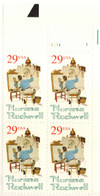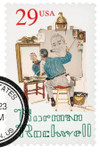
# 2839 - 1994 29c Norman Rockwell
U.S. #2839
1994 Norman Rockwell (single)
- Issued for the 100th birth anniversary of Norman Rockwell (along with a souvenir sheet of four other stamps)
- Pictures Rockwell’s iconic painting Triple Self-Portrait
Stamp Category: Commemorative
Value: 29¢, First Class Mail Rate
First Day of Issue: July 1, 1994
First Day City: Stockbridge, Massachusetts
Quantity Issued: 209,000,000
Printed by: Bureau of Engraving and Printing
Printing Method: Offset, Intaglio
Format: Panes of 50 (Vertical 10 across, 5 down)
Perforations: 11.1 (Eureka off-line perforator)
Tagging: Prephosphored paper
Why the stamp was issued: To honor one of the greatest American artists of all time – Norman Rockwell (1894-1978) – on the 100th anniversary of his birth.
About the stamp design: Pictures Norman Rockwell’s iconic Triple Self-Portrait, which first appeared on the cover of The Saturday Evening Post on February 13, 1960. The painting shows Rockwell leaning to the side to look at himself in the mirror next to his easel. The mirror shows a less idealized version of Rockwell than appears on the in-progress painting on his canvas.
Special design details: Triple Self-Portrait includes small details that came to be Rockwell’s trademark. There’s a cigarette in a bucket, a vintage war helmet hung atop the easel, and reproductions of four classic self-portraits pinned to his canvas: Durer, Rembrandt, Picasso, and Van Gogh. The words “Norman Rockwell” beneath the stamp vignette were created in the hollow-square letters Rockwell himself used to sign his paintings.
First Day City: This stamp, along with the four-stamp Norman Rockwell souvenir sheet, was issued in Stockbridge, Massachusetts, at the Norman Rockwell Museum.
History the stamp represents: Fifteen years after his death, Norman Rockwell is still one of the nation’s best-loved artists and perhaps the only artist known to millions of everyday Americans. So it is only fitting that five stamps depicting some of his best-known works were issued in 1994, the 100th anniversary of his birth.
Capturing life in the United States for more than half a century, his paintings were often of ordinary people in everyday situations. During his 64-year career, Rockwell painted over 4,000 works, including 321 Saturday Evening Post covers. He also illustrated covers for many other magazines including Family Circle, Life, McCall’s, Popular Science, and TV Guide. Although good training, technique, and meticulous research all played a part, much of his popularity is due to the sensitivity and deep affection he brought to his subjects.
In a tribute to this remarkable artist, author Robin Langley Sommer stated, “His feeling for the beauty and importance of everyday life was of a rare order, and his ability to make others feel it as well was surely not far removed from genius. This gift for perceiving what E.B. White called the glory of everything is Norman Rockwell’s most enduring legacy.”
U.S. #2839
1994 Norman Rockwell (single)
- Issued for the 100th birth anniversary of Norman Rockwell (along with a souvenir sheet of four other stamps)
- Pictures Rockwell’s iconic painting Triple Self-Portrait
Stamp Category: Commemorative
Value: 29¢, First Class Mail Rate
First Day of Issue: July 1, 1994
First Day City: Stockbridge, Massachusetts
Quantity Issued: 209,000,000
Printed by: Bureau of Engraving and Printing
Printing Method: Offset, Intaglio
Format: Panes of 50 (Vertical 10 across, 5 down)
Perforations: 11.1 (Eureka off-line perforator)
Tagging: Prephosphored paper
Why the stamp was issued: To honor one of the greatest American artists of all time – Norman Rockwell (1894-1978) – on the 100th anniversary of his birth.
About the stamp design: Pictures Norman Rockwell’s iconic Triple Self-Portrait, which first appeared on the cover of The Saturday Evening Post on February 13, 1960. The painting shows Rockwell leaning to the side to look at himself in the mirror next to his easel. The mirror shows a less idealized version of Rockwell than appears on the in-progress painting on his canvas.
Special design details: Triple Self-Portrait includes small details that came to be Rockwell’s trademark. There’s a cigarette in a bucket, a vintage war helmet hung atop the easel, and reproductions of four classic self-portraits pinned to his canvas: Durer, Rembrandt, Picasso, and Van Gogh. The words “Norman Rockwell” beneath the stamp vignette were created in the hollow-square letters Rockwell himself used to sign his paintings.
First Day City: This stamp, along with the four-stamp Norman Rockwell souvenir sheet, was issued in Stockbridge, Massachusetts, at the Norman Rockwell Museum.
History the stamp represents: Fifteen years after his death, Norman Rockwell is still one of the nation’s best-loved artists and perhaps the only artist known to millions of everyday Americans. So it is only fitting that five stamps depicting some of his best-known works were issued in 1994, the 100th anniversary of his birth.
Capturing life in the United States for more than half a century, his paintings were often of ordinary people in everyday situations. During his 64-year career, Rockwell painted over 4,000 works, including 321 Saturday Evening Post covers. He also illustrated covers for many other magazines including Family Circle, Life, McCall’s, Popular Science, and TV Guide. Although good training, technique, and meticulous research all played a part, much of his popularity is due to the sensitivity and deep affection he brought to his subjects.
In a tribute to this remarkable artist, author Robin Langley Sommer stated, “His feeling for the beauty and importance of everyday life was of a rare order, and his ability to make others feel it as well was surely not far removed from genius. This gift for perceiving what E.B. White called the glory of everything is Norman Rockwell’s most enduring legacy.”









